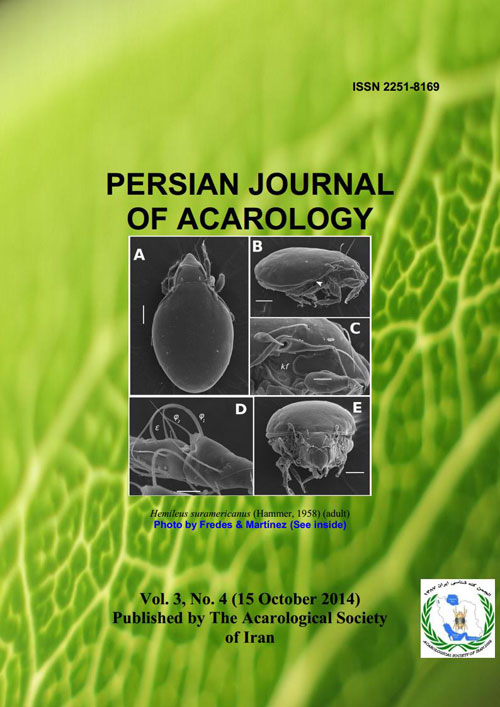فهرست مطالب

Persian Journal of Acarology
Volume:3 Issue: 4, Autumn 2014
- تاریخ انتشار: 1393/10/10
- تعداد عناوین: 7
-
-
Page 249This paper represents the first redescription of Hemileius suramericanus (Hammer, 1958) (Oribatida, Scheloribatidae). Morphological and chaetotactic details are added to original Hammer's description. The species is compared with others Neotropical species of Hemileius and two new synonyms, H. laticlava and H. confundatus sensu Hammer, are proposed.Keywords: Morphology, chaetotaxy, Neotropical species, Argentina, new synonyms
-
Page 257We studied oribatid mite diversity in two sites of virgin Pleistocene forests in Borjom-Kharagauli National Park in Georgia. The aim was to explore the effects of microhabitat and tree species on the composition and the relative abundance of oribatid mites. Investigations revealed high species richness (96 species in total) with community composition varying according to the microhabitat type. Carabodes tenuis Forsslund, 1953 was registered for the first time for Caucasian fauna. Soil and canopy (twig)-dwelling oribatid communities comprises rather distinctive groups unlike moss and litter. No difference was observed between moss and litter dweller mites. One species, Camisia horrida (Hermann, 1804), was found only in canopy samples, but was very rare. Poroliodes farinosus (C.L. Koch, 1840), Carabodes labyrinthicus (Michael, 1879) and Phauloppia rauschensis (Sellnick, 1908) were found frequently in canopy habitats, with P. rauschensis abundant on tree twigs and almost absent from forest floor. The presence of beech trees (Fagus orientalis Lipsky) was correlated with the number of species per site. The results showed that geographic distance between sites is an important determinant in oribatid community composition and can have stronger effects than a microhabitat type.Keywords: Cryptostigmata, biodiversity, Pleistocene forests, microhabitat preference
-
Page 277A survey to study of mites associated with pomegranate in Mahvelat region, Khorasan Razavi province, northeastern Iran, in 2013 led to find three species of the superfamily Pygmephoroidea (Acari: Prostigmata: Heterostigmata) new to mite fauna of Asia. The materials have been collected from soil samples. These three species belong to three families of the mentioned superfamily as follows: Premicrodispus longicaudus Khaustov, 2006 (Microdispidae), Kerdabania variabilis Khaustov, 2009 (Neopygme-phoridae), Neositeroptes opacus Livshits, Mitrovanov & Sharonov, 1986 (Pygmephor-idae). A key to Iranian Pygmephoroidea (excluding Scutacaridae) recovered from soil samples is provided.Keywords: Mite, Microdispidae, Neopygmephoridae, Pygmephoridae, soil, Iran
-
Page 285A new species of the genus Stigmaeus, Stigmaeus sariensis Bagheri sp. nov., collected from soil under Oak trees (Quercus sp.) and on moss, is described and illustrated from Sari city, Mazandaran province, IranKeywords: Prostigmata, Raphignathoidea, predatory mites, systematics, Mazandaran province
-
Page 293In order to study the species richness of oribatid mites in rangelands of West Azerbaijan Province (Northwestern Iran), soil samples were taken in eight different sites of rangelands including Ghooshchi (16001750 and 17502000 m a.s.l), Ghasemloo (13001450, 14501600 and 16001750 m a.s.l) Roze-Chai (14501600 m a.s.l), Marmisho (17502000 m a.s.l) and Ordooshahi (13001450 m a.s.l) areas at three different times (mid-May, mid-August and mid-October) of the year 2012. In total, 71 species belonging to 49 genera, 32 families and 20 superfamilies were collected and identified. The oribatid species richness was calculated for all the samples with the Ecological Methodology 6.0 software. One-way ANOVA revealed significant differences (PKeywords: Altitude, rarefaction, richness, soil mites, diversity
-
Page 311A new species of the genus Favognathus Luxton is described from Iran, namely: F. naghii Hassanzadeh, Khanjani & SafarAlizadeh sp. nov., collected from soil and litter under Cydonia oblonga Mill. (Rosaceae), Sardasht vicinity, Western Azerbaijan Province, Iran. Also, a key to all known species of the genus Favognathus is presented here.Keywords: Plant, terrestrial mite, litter, lichen, mosses
-
Page 321Two new eriophyoid species belonging to subfamily Phyllocoptinae, namely Tegonotus larii sp. nov. and Tetra iranica sp. nov. from Phoenix dactylifera L. (Arecaceae) in Lar city, Fars Province, southern Iran, are described and illustrated. Detailed morphological characteristics are given based on adult females. Both new species described herein are vagrants on their host plants. No symptoms were observed.Keywords: Trombidiformes, Eriophyoidea, Arecaceae, Lar city, Fars Province

